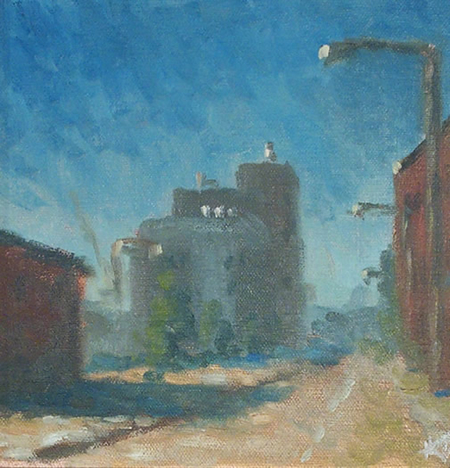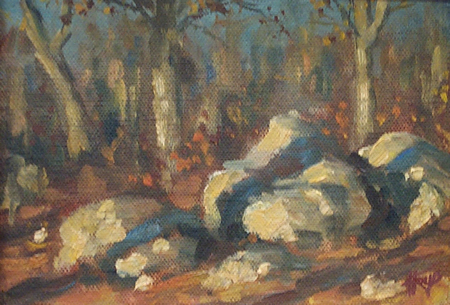Finding Your Voice How artists discover who they are

Oil on panel, 8×8 inches / 20×20 cm, 2005
On Sunday I had brunch with a friend.
We ate in classic old railway car style diner in Rhode Island, which the waitress said had been built in the 1950s and moved up from South Carolina a few decades ago.
The food was acceptable – my Eggs Benedict were good-not-great, but the atmosphere was stellar; we sat under original unpainted pressed tin ceilings, vintage advertising signs, and a framed print of Norman Rockwell’s iconic triple self-portrait, which I absolutely adore.
Though not an artist himself, this friend is keenly interested in the arts and the creative process, so we often talk about this when we visit.
YouTube had recently suggested a video for him about how artists find their own unique voice – he didn’t remember the name of the artist, and doesn’t have the YouTube app installed on his phone, so we couldn’t look at his viewing history to find the video.
But we did talk about the content, and he asked me what I thought about it.

Oil on canvas, 6×8 inches / 15×20 cm, 2006
The gist of the video is that a beginning artist essentially has no idea what kind of artist they are, and the only way to proceed is to try a little bit of everything – styles, subjects, techniques – eventually what is right for each individual will rise to the surface above all the others. (When I worked in technology, we called this approach the Spaghetti Method: You throw a bunch of spaghetti at the wall and if anything sticks, you know you have a winner… metaphorically, of course).
By following this approach for a long time – usually years – the prospective artist will come to know who they really are and what it is they have to say – in that way the young artist begins to find their own authentic personal voice.
It’s good advice – probably the only good advice on the subject, and it mirrors my own experience.
I came to painting late – I was 30 and it began as just a weekend hobby – but that is basically how I proceeded.
At first, I tried a little of everything – pen and ink, charcoal, oil, acrylic, watercolor. I worked from photos, from life, from memory and imagination. I painted landscape, still life, some very regrettable portraits – even a few abstracts (the latter were fun in the way that finger painting is fun, but I didn’t take that path too seriously).

Oil on canvas, 20×24 inches / 50×60 cm, 2004
I worked that way for a couple of years, and eventually the thing that rose to the top above everything else was… plein air landscape painting.
Yes; my first artistic identity was as a landscape painter, and for the following 7 or 8 years I did very little else – nearly every day I could I was out painting in the woods, at the shore, around town, at the edges of farm fields – even a trip to Mexico to paint the small villages and Aztec ruins. If the weather made working outside impossible, I would drive someplace interesting, and make small sketches in my car.
Eventually, though, a quieter voice began to assert itself: Return to the studio, look around you, and start to paint the poetry of the humble objects you see every day.
And so I became a still life painter, and have done very little else for the past 15 years.
If there is a moral to this story, it’s probably this: A beginning artist does not know who they are at all, and should try as wide a range as possible to see what truly resonates with them.
But – and this is probably the most important part – never stop listening, either; you never know when that quiet little voice in the back of your head will tell you the thing that really matters.